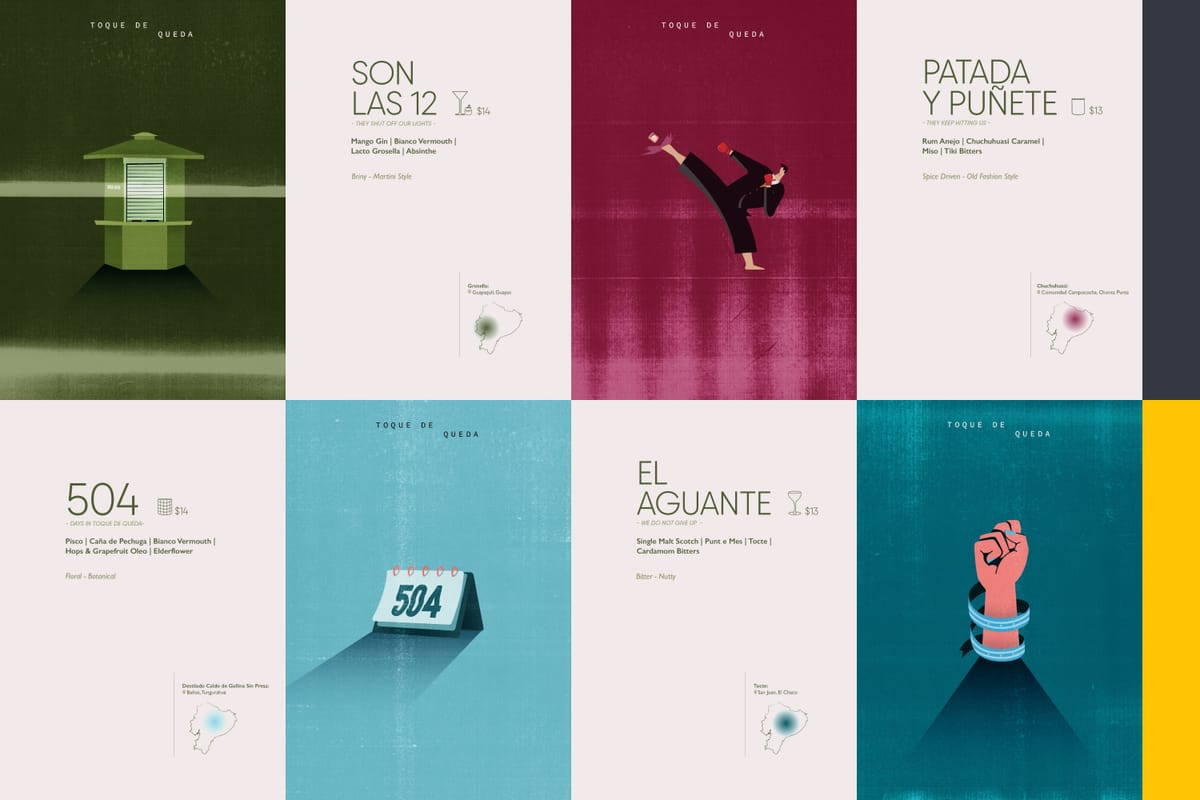Drink Menu Examples That Inspire: From Local Bars to Global Chains

Creating a drink menu is a fun and important part of running a bar or restaurant. Whether it's a cozy local spot or a big global chain, the drinks on the menu can tell a story and make customers excited. This article explores different drink menu examples that inspire creativity and connection to the community.
Key Takeaways
- Local bars often showcase their unique drinks that highlight local flavors and ingredients.
- Global chains focus on having popular drinks that taste the same no matter where you are.
- Seasonal menus change with the time of year, using fresh ingredients and special offers to attract customers.
- Non-alcoholic drinks are becoming more popular, with tasty mocktails that appeal to everyone.
- Technology is changing how we see drink menus, making it easier for customers to learn about their options.
Crafting Unique Drink Menus at Local Bars
Creating a drink menu that stands out is essential for local bars. It not only attracts customers but also reflects the bar's personality. Here are some key elements to consider:
Spotlight on Signature Cocktails
- Create a Unique Identity: Develop a few signature cocktails that represent your bar's theme or location.
- Engage Customers: Encourage customers to share their experiences with these drinks on social media.
- Seasonal Specials: Rotate signature cocktails based on the season to keep the menu fresh.
Incorporating Local Ingredients
- Support Local Farmers: Use ingredients sourced from nearby farms to create a connection with the community.
- Highlight Local Flavors: Incorporate regional fruits, herbs, and spirits to give your drinks a unique twist.
- Promote Sustainability: Using local ingredients can reduce transportation costs and environmental impact.
Balancing Classics with Innovations
- Mix Old and New: Offer classic cocktails alongside innovative creations to cater to all tastes.
- Experiment with Flavors: Try new flavor combinations while keeping some traditional recipes intact.
- Customer Feedback: Regularly ask customers for their opinions on new drinks to refine your offerings.
Global Chains and Their Iconic Drink Offerings
Understanding Global Palates
Global chains often create drink menus that cater to a wide range of tastes. They consider the preferences of different cultures and regions. Here are some key points:
- Diverse Flavors: Chains offer drinks that reflect local tastes, such as spicy flavors in Mexico or fruity options in tropical areas.
- Cultural Influences: Drinks may include ingredients that are popular in specific countries, like matcha in Japan or coconut in the Caribbean.
- Feedback and Trends: Many chains use customer feedback to adjust their menus and keep up with drink trends.
Consistency Across Locations
One of the main goals for global chains is to provide a similar experience no matter where you are. This means:
- Standard Recipes: Each drink has a set recipe to ensure the same taste everywhere.
- Quality Control: Chains often have strict guidelines to maintain the quality of their drinks.
- Training Staff: Employees are trained to make drinks the same way, so customers know what to expect.
Adapting to Local Tastes
While consistency is important, global chains also adapt their menus to fit local preferences. This can include:
- Seasonal Ingredients: Using local fruits and herbs that are in season.
- Specialty Drinks: Creating unique drinks that are only available in certain locations.
- Customer Input: Listening to what local customers want and making changes based on their suggestions.
The Art of Seasonal Drink Menus
Creating seasonal drink menus is a fantastic way to keep your offerings fresh and exciting. Here are some key points to consider:
Embracing Seasonal Ingredients
- Freshness: Using ingredients that are in season ensures the best flavor and quality.
- Local Sourcing: Support local farmers and suppliers by incorporating their seasonal produce.
- Variety: Seasonal ingredients allow for a diverse range of flavors and combinations.
Creating Limited-Time Offers
- Highlighting Specialties: Feature unique drinks that are only available for a short time.
- Creating Buzz: Limited-time offers can create excitement and encourage customers to visit more often.
- Testing New Ideas: Use these offers to experiment with new flavors and concepts before adding them to the main menu.
Marketing Seasonal Specials
- Social Media Promotion: Use platforms like Instagram and Facebook to showcase your seasonal drinks.
- Engaging Descriptions: Write enticing descriptions that highlight the ingredients and flavors.
- In-Store Signage: Use eye-catching signs to draw attention to seasonal offerings in your bar or restaurant.
Innovative Non-Alcoholic Drink Menu Examples
Crafting Flavorful Mocktails
Creating delicious mocktails is a great way to attract customers who prefer non-alcoholic options. Here are some popular mocktail ideas:
- Virgin Mojito: A refreshing mix of mint, lime, and soda.
- Pineapple Ginger Sparkler: A zesty blend of pineapple juice and ginger ale.
- Berry Fizz: A fruity combination of mixed berries and sparkling water.
Incorporating Health Trends
Health-conscious customers are looking for drinks that not only taste good but are also good for them. Here are some trends to consider:
- Low-Sugar Options: Use natural sweeteners like honey or agave.
- Superfood Ingredients: Add items like chia seeds or spirulina for extra nutrition.
- Herbal Infusions: Use herbs like basil or rosemary for unique flavors.
Appealing to a Wider Audience
To make your non-alcoholic menu more inviting, consider these strategies:
- Diverse Flavor Profiles: Offer a range of flavors from sweet to spicy.
- Creative Names: Give your drinks fun and catchy names to spark interest.
- Inclusive Options: Ensure there are choices for various dietary needs, like vegan or gluten-free.
The Role of Presentation in Drink Menus
Visual Appeal and Menu Design
The way a drink menu looks can really grab a customer's attention. Here are some key points to consider:
- Color Scheme: Use colors that match the theme of your bar or restaurant.
- Font Choice: Choose easy-to-read fonts that fit the style of your place.
- Layout: Organize drinks in a way that makes it easy for customers to find what they want.
Using Descriptive Language
Words matter! Describing drinks in a tasty way can make them more appealing. Here are some tips:
- Use Sensory Words: Describe how drinks smell, taste, and look.
- Highlight Unique Ingredients: Mention special items that make your drinks stand out.
- Create a Story: Share a little background about the drink or its ingredients to connect with customers.
Highlighting Unique Ingredients
Showcasing special ingredients can make your drinks more interesting. Consider these ideas:
- Local Ingredients: Mention if you use local fruits or herbs.
- Craft Spirits: Highlight any unique spirits that are hard to find.
- Seasonal Flavors: Talk about how your drinks change with the seasons to keep things fresh.
By focusing on how your drink menu looks and sounds, you can create a more inviting experience for your customers.
Technology's Impact on Modern Drink Menus
Digital Menus and Customer Interaction
In today’s world, many bars and restaurants are using digital menus. These menus can be displayed on screens or accessed through smartphones. This change helps customers in several ways:
- Easy Updates: If a drink is out of stock or a new item is added, it can be changed quickly.
- Interactive Features: Customers can click on drinks to see more details, like ingredients and prices.
- Feedback Options: Some digital menus allow customers to rate drinks or leave comments.
Utilizing QR Codes for Drink Details
QR codes are small squares that can be scanned with a smartphone. They are becoming popular in drink menus for these reasons:
- Quick Access: Customers can scan the code to see the full drink menu without needing a physical copy.
- Special Offers: Bars can use QR codes to share discounts or special promotions.
- Sustainability: Using QR codes reduces the need for printed menus, which is better for the environment.
Personalizing Drink Recommendations
Technology is also helping bars suggest drinks that customers might like. Here’s how:
- Data Collection: Bars can track what drinks are popular and what customers order most.
- Tailored Suggestions: Based on past orders, bars can recommend drinks that match a customer’s taste.
- Loyalty Programs: Some places offer rewards for frequent customers, making their drink choices even more personalized.
Sustainability in Drink Menu Design
Creating a drink menu that is friendly to the environment is becoming more important for bars and restaurants. Here are some ways to make drink menus more sustainable:
Sourcing Sustainable Ingredients
- Local Produce: Use fruits, herbs, and other ingredients that are grown nearby. This helps support local farmers and reduces transportation emissions.
- Organic Options: Choose organic ingredients when possible. They are grown without harmful chemicals, which is better for the planet.
- Seasonal Selections: Focus on ingredients that are in season. They are fresher, taste better, and have a lower environmental impact.
Reducing Waste in Drink Preparation
- Measure Ingredients: Use precise measurements to avoid overpouring and wasting ingredients.
- Repurpose Leftovers: Use leftover fruits and herbs in new drinks or as garnishes to minimize waste.
- Compost: Set up a compost system for organic waste from drink preparation, turning scraps into useful soil.
Promoting Eco-Friendly Practices
- Reusable Straws: Offer metal or bamboo straws instead of plastic ones to cut down on plastic waste.
- Eco-Friendly Packaging: Use biodegradable or recyclable materials for takeout drinks.
- Educate Customers: Share information about your sustainable practices on the menu or through staff to encourage customers to support eco-friendly choices.
When designing a drink menu, it's important to think about sustainability. Using local ingredients and eco-friendly practices can make your menu not only delicious but also good for the planet. Want to learn more about how to create a sustainable drink menu? Visit our website for tips and resources!
Final Thoughts
In conclusion, a well-thought-out drink menu can really make a difference for any bar or restaurant. Whether it’s a cozy local spot or a big global chain, the drinks they offer can attract customers and keep them coming back. By mixing classic favorites with unique creations, places can create a fun and exciting experience for everyone. So, whether you’re sipping a craft cocktail or enjoying a simple soda, remember that the drink menu plays a big role in making your time out special.
Frequently Asked Questions
What makes a drink menu unique at local bars?
Local bars often create special drinks that use ingredients from their area. They might have a drink that represents their town or features local flavors.
How do global chains keep their drink menus the same everywhere?
Global chains make sure their drinks taste the same by using the same recipes and ingredients in all their locations. This way, customers know what to expect no matter where they are.
Why are seasonal drinks popular?
Seasonal drinks are popular because they use fresh ingredients that are in season. They also change with the time of year, making them exciting and new for customers.
What are mocktails and why are they important?
Mocktails are non-alcoholic drinks that taste great. They are important because they give people who don't drink alcohol a fun option that still feels special.
How does the way a drink is presented matter?
The way a drink looks can make it more appealing. A nice presentation can attract customers and make them want to try something new.
How has technology changed drink menus?
Technology has changed drink menus by allowing bars to use digital menus. This makes it easy for customers to see drink options and learn more about them through their phones.





